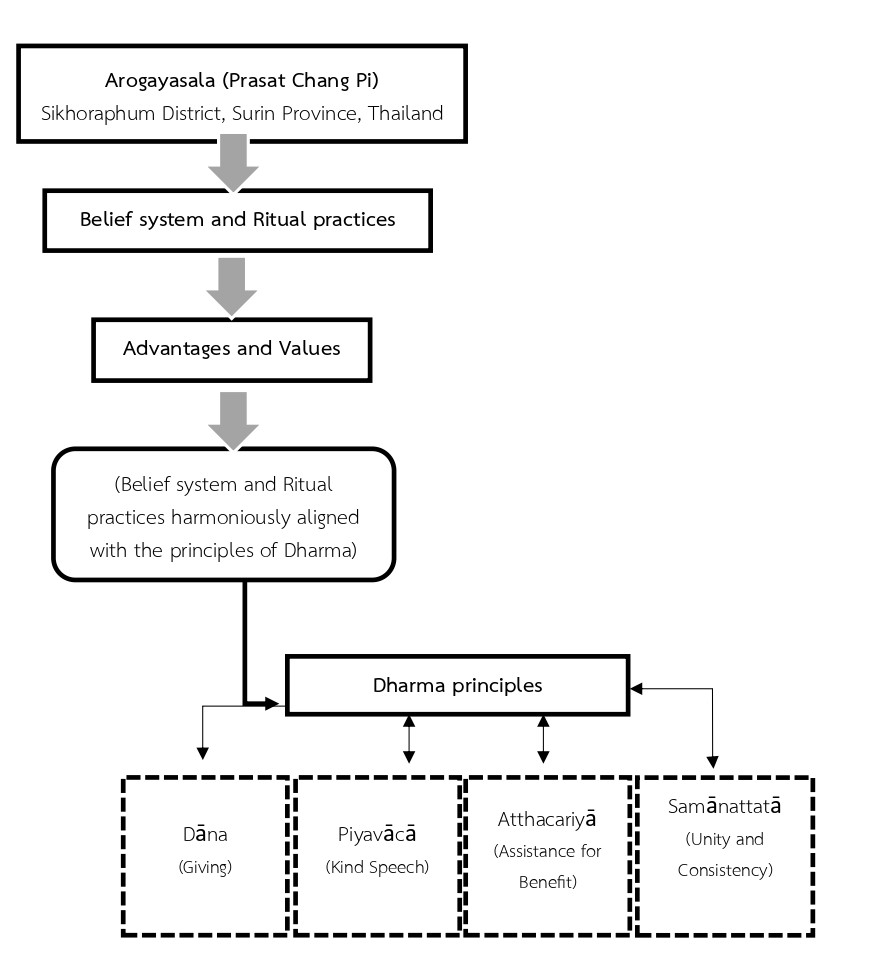DHARMA PRINCIPLES BASE ON BELIEF AND RITUAL WITH AROGAYASALA (PRASAT CHANG PI) IN SIKHORAPHUM DISTRICT, SURIN PROVINCE, THAILAND
Keywords:
Dharma Principles, Belief, Ritual, Arogayasala (Prasat Chang Pi), Surin ProvinceAbstract
Background and objectives: Arogayasala (Prasat Chang Pi) in Chang Pi Village, Thailand, had a historical context rooted in Khmer culture and Buddhism. It was associated with healing beliefs and rituals, reflecting values of spirituality, compassion, and communal unity. These beliefs and rituals aligned with Dharma principles, emphasizing interconnectedness and mutual support, ultimately strengthening community bonds. This research aimed to explore the historical context of Arogayasala (Prasat Chang Pi) and investigate how its belief system and ritual practices aligned with Dharma principles and Buddhist tenets in Chang Pi Village, Sikhoraphum District, Surin Province, Thailand.
Methodology: This qualitative research employed in-depth interviews and participatory observation to investigate beliefs and rituals associated with Arogayasala in Sikhoraphum District, Surin Province, Thailand. Six interviews with community leaders and ritual conductors were conducted. Content analysis techniques were applied to the collected data. Descriptive analysis was employed. Data quality was ensured through triangulation, classification, categorization, theming, and interpretation techniques.
Main Results: Arogayasala held historical significance, rooted beliefs, and impactful rituals for the Khmer community in Chang Pi Village. Dating back to the 18th century of the Buddhist Era, it reflected King Jayavarman VII's dedication to healing. The belief system brought unity and prosperity through unwavering faith in unseen powers, observed in an annual ritual with guardian spirits. Arogayasala, with roots dating back to the 18th century of the Buddhist Era, held historical importance for the Khmer community in Chang Pi Village, reflecting King Jayavarman VII's commitment to healing. Its belief system fostered unity and prosperity through unwavering faith in unseen powers. It manifested in an annual ritual involving guardian spirits of Arogayasala in Chang Pi Village, which stood as a testament to historical significance, deep-rooted beliefs, and transformative rituals that had profoundly impacted the Khmer community. Established around the 18th century of the Buddhist Era, it reflected King Jayavarman VII's dedication to healing. Archaeological evidence could have supported its role as a haven of protection and wellness. The belief system surrounding Arogayasala served as a pillar of unity and prosperity, rooted in unwavering faith in unseen powers. Annual rituals seamlessly intertwined religion and superstition, offering solace and protection that passed down through generations. These practices fostered unity, preserved traditions, and enhanced personal growth. Arogayasala's belief system harmonized with Dharma principles, reflecting unity, selflessness, and consistent commitment, embodying a timeless legacy within the Thai-Khmer community.
Involvement to Buddhadhammaส่วนบนของฟอร์ม: This research highlights the significance of belief systems and rituals associated with Arogayasala in Surin Province's historical sites. The inherent advantages and values lie in their capacity to foster community connections, solidarity, and unity, promoting harmony. The community's principles, encapsulated in their beliefs and rituals, include four Dharma principles: Dāna (Giving), Piyavācā (Kind Speech), Atthacariyā (Assistance for Benefit), and Samānattatā (Unity and Consistency).
Conclusions: Arogayasala's significance extended beyond history, embodying values such as comfort, tradition preservation, personal growth, and community unity. Its rituals seamlessly blended religion and superstition, providing solace and protection. Adherence to respectful practices, handed down through generations, not only preserved tradition but also fostered unity and countered negativity. Established in Chang Pi Village during the 18th century of the Buddhist Era, Arogayasala reflected King Jayavarman VII's commitment to healing, serving as a beacon of cultural heritage, spirituality, and shared purpose within the Thai-Khmer community.
References
Chanthawanit, S. (2007). The data analysis in Qualitative Research. Chulalongkorn University.
Chantong, I. (1994). Social function of the "Kallmor" ritual among the Kui of Samrong Thap Surin province. [Master's thesis, Silpakorn University]. Silpakorn University Repository: SURE. https://sure.su.ac.th/xmlui/handle/123456789/1653.
Chittham, P. (1975). Belief. Ramkhamhaeng Journal, 2(2), 54-72.
Coede, G. (1993). Mueng Phra Nakhorn Nakornwat Nakorntom. Matichon.
Geertz, C. (1973). The Interpretation of the Cultures. The Basic Books.
Howard, M. C. (1992). Anthropology: Understanding Human Adaptation. Harper Collins publisher Inc.
Kaewklai, C. (2001). Inscription of Prasat Ta Muen Tom. Silpakorn, 42(2), 71-72.
Kasemsukjarasseang, S. (1983). Mixture of Lao Song or Thai Chong's Culture. Surindra Rajabhat University.
Khearam, P. (1992). Mamuad Rites of Thai Khmer Ethnics: A Case Study of Tako Rai Village, Nabua, Mueng, Burirum Province. [Unpublished master's thesis. Mahasarakham University.
Lawrence, R. (1999). Unlock Your Psychic Powers: Science of Power, Translated by Somchai Sumritsup. Master Pring Ting.
Manitjarern, M. (1971). New Modern Dictionary. Karnpim Phranakorn.
Payormyong, M. (1986). Lanna Culture. Thai Wattana Panit.
Phra Tienwit Attasanto (Ochawat). (2005). A Study of the Buddhist Beliefs and Rituals of Spirit Mediumships: A Case Study in Bangkok. [Unpublished master's thesis]. Mahachulalongkornrajavidyalaya University.
Punnotok, T. (1985). Local Culture: Ideological Belief in Local Culture. Chulalongkornrajavidyalaya.
Royal Institution. (2003). Dictionary of Royal Institution. Nan Me book Publication Company.
Sergeant, D. (1999). Global Ritualism. World Rites, Translated by Tipayaarpa (Pen name). June Publishing.
Sumetharat, S. (2010). History of Local Surin. Faculty of Humanities and Social Sciences. Surindra Rajabhat University: Sor Panpen.
Veawveerakubta, N. (1993). Sacrifice to the Destiny: The Role of Remaining Belief in the Case Study of the Destruction of the Fortune of Wat Bot, Ban Leuk, Amphoe Photharam, Ratchaburi. [Unpublished master's thesis]. Silpakorn University.
Yoddamnoen, B., Sirirusmi, B. & Boonchalaksi, W. (1994). Qualitative Research: Fieldwork Technique. Mahidol University.

Downloads
Published
How to Cite
Issue
Section
License
Copyright (c) 2023 Journal of Buddhist Anthropology

This work is licensed under a Creative Commons Attribution-NonCommercial-NoDerivatives 4.0 International License.







